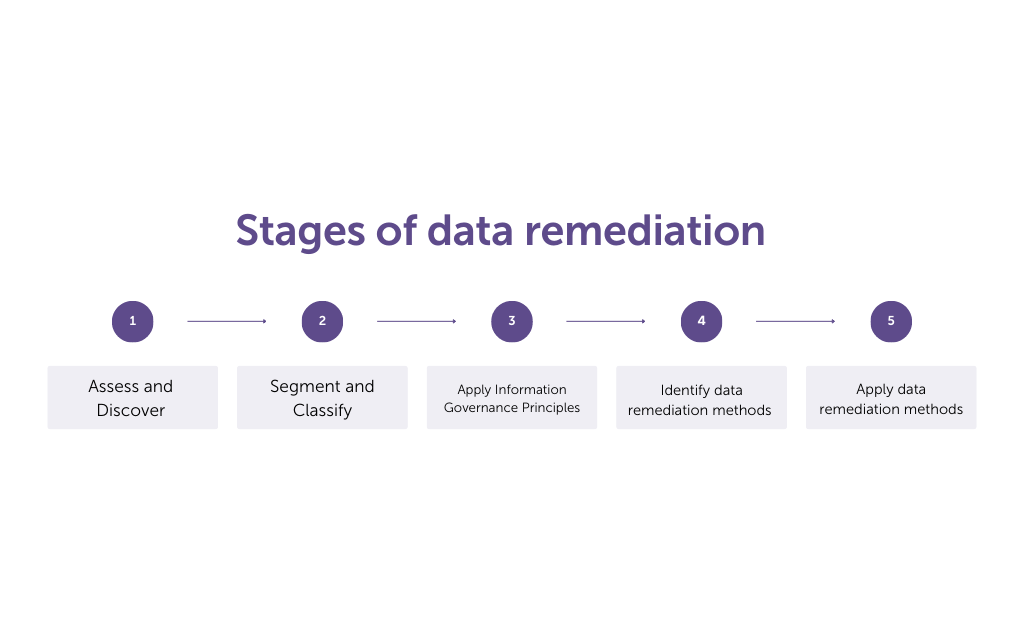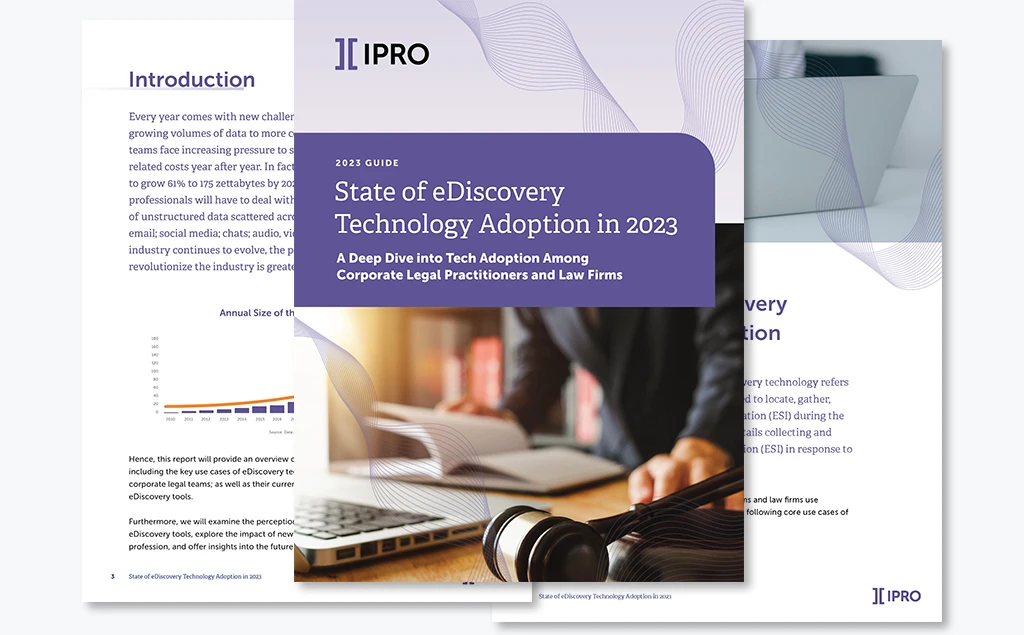
Introduction
Data is like the mail: it just keeps coming in, day after day. Storing and maintaining it is a never-ending process. Excess data can slow down operations, diminishing a law firm’s productivity, profitability, and public image. Hence law firms must also continually assess, organize, and, where appropriate, delete their data, a process collectively known as data remediation.
In this post, we’ll define data remediation and outline its stages. Then, we’ll discuss the risks of inefficient data remediation practices and explain when it is necessary. Finally, we’ll share how to prepare for data remediation and five best practices for performing this process efficiently in 2023.
Contents
What is data remediation?
How is data remediation connected to data quality?
What are the stages of data remediation?
The importance of data remediation for law firms
The risks of inefficient data remediation
When is data remediation necessary for law firms?
How to prepare for data remediation
5 data remediation best practices for your law firm
Technology can help your law firm perform efficient data remediation
What is data remediation?
Data remediation is the process of ensuring the quality and security of stored information by fixing errors and organizing, cleansing, deleting, migrating, and archiving data.
Data remediation is more than just sifting through and deleting outdated and unnecessary data. It also involves minimizing data, making corrections when data has been compromised, making sure data is readily accessible, enhancing data security, and ensuring data compliance.
How is data remediation connected to data quality?
Data remediation and data quality are closely intertwined; as noted above, an important part of remediation is ensuring data quality. Good data quality exists when data is accurate, complete, consistent, reliable, and up to date. Periodic issues with each of these areas are unavoidable, especially where large volumes of data are concerned. Data remediation aims to fix those issues.
What are the stages of data remediation?
Data remediation has five stages, as follows:

Let’s take a closer look at each of these stages.
- Assess and discover
First, you must assess your law firm’s data. This assessment should reveal how much data your law firm has, what types of data it has, and whether there are any potential issues relating to that data. Careful assessment can help your team understand what remediation is necessary so you can plan and make corrections accordingly.
- Segment and classify
Organizing and categorizing data into different segments based on its purpose and nature is an integral part of efficient data remediation. Most law firms can segment their data into four categories:
- business data that staff needs daily access to;
- sensitive data that requires secure storage;
- business records data that can be archived; and
- redundant, obsolete, and trivial (ROT) data that can be deleted.
By separating sensitive data into its own segment, your law firm can save money by storing only sensitive data in its highest-security repository. Likewise, data that your law firm needs daily access to might be best stored in the cloud, whereas you can archive data that you are retaining simply for compliance purposes. You should also identify ROT data so you can delete it.
- Apply information governance principles
Once you have taken an inventory of your law firm’s data, you should turn to your law firm’s information governance policies. Information governance describes a set of rules and policies that govern who uses data and how they can use it. By cross-referencing your law firm’s information governance policies with the state of its data, you can determine what data needs remediation.
- Identify data remediation methods
Before kicking off the process, you first must identify what remediation methods are appropriate to meet your needs. Examples of data remediation methods include modification, masking, redaction, deidentification, cleansing, migration, quarantining, and deletion.
You will likely need to apply different methods to different sets of data. The methods you choose depend on the issues you’ve identified with each data set and what your law firm’s information governance policies require.
- Apply data remediation methods
Finally, your team must apply the data remediation methods you have chosen. This application should, of course, abide by your law firm’s information governance policies and any relevant laws and regulations. It should also account for any goals and priorities your law firm identified before you began the remediation process.
Now let’s talk about why it is so important for law firms.
The importance of data remediation for law firms
Data remediation is crucial for helping law firms meet their business goals. By conducting it efficiently, law firms can:
- improve the quality of their data and reduce cybersecurity risks by properly classifying data and ensuring it’s stored in an appropriately secure location;
- reduce the costs associated with storing excessive data, defending against data-related lawsuits, and responding to regulatory inquiries regarding data; and
- increase their efficiency and productivity by providing easier access to data and enabling quicker decision-making.
Efficient data remediation can also help law firms avoid many data-related risks, which we’ll explore in the following section.
The risks of inefficient data remediation
Even if a law firm performs occasional data remediation, doing so infrequently or inefficiently can increase certain risks. Specifically, a law firm’s failure to regularly assess and address data-related issues puts it at risk of non-compliance with various laws, rules, and regulations, which can result in fines, regulatory proceedings, and loss of public trust.
Further, failure to regularly delete ROT data leads to higher volumes of stored data, including sensitive data. This results in greater data storage costs and leaves law firms more vulnerable to data non-compliance and cybersecurity risks. Cyberattacks in particular can have very costly consequences, including investigations, remedial measures, fines, and reputational damage.
Efficient data remediation can help law firms avoid these risks. But what events should trigger your law firm to perform it?
When is data remediation necessary for law firms?
Data remediation is necessary for law firms when internal or external changes take place. These changes include:
- Logistical changes: Changes in a law firm’s business environment, such as new hardware or software, relocation, or leadership turnover typically warrant data remediation. Any time data moves, or new leadership enters the picture is a good time to re-evaluate your law firm’s data quality and security, both because further data migration or deletion may be warranted and new leaders typically have different expectations.
- Mergers and acquisitions: A law firm should remediate all of its data after a merger or acquisition. That way, it can ensure organization-wide consistency in data quality and security and prevent any issues that newly added data may present.
- New laws and regulations: New or amended laws, rules, and regulations often place additional restrictions on data, especially when it comes to sensitive data. Therefore, legal and regulatory changes may necessitate remediation to ensure continued data compliance.
- Internal policy changes: Much like new laws and regulations, new or amended internal policies may require data remediation to ensure internal compliance.
- Discovery of human error: Mistakes are inevitable when people interact with data. When a law firm discovers human error, it must use data remediation to mitigate any harm done and maintain ongoing data quality and security.
If any events like these have affected your law firm, you should prepare for and perform data remediation as soon as possible. Here’s how.
How to prepare for remediation of data
There are a few steps your law firm should take before diving into data remediation. You can prepare for data remediation by:
- adopting clear information governance policies;
- identifying your data remediation goals and priorities, perhaps based on the triggering event (such as a merger or acquisition);
- determining the scope of the remediation project, including its cost and the number of people needed to effectively perform it within a reasonable amount of time;
- setting a budget that includes not only your anticipated costs but also an allowance for unanticipated costs in case unforeseen issues arise; and
- assembling a team, clearly defining each member’s role and responsibilities, and setting clear expectations.
Once you have prepared your team, you can perform data remediation efficiently using these best practices.
5 data remediation best practices for your law firm
Data remediation can be complicated. It requires solid teamwork, an understanding of information governance principles, planning, and foresight. To perform data remediation in a way that best suits your law firm’s business needs, here are five best practices you can apply in 2023.
1. Set clear expectations
Because data remediation is a team effort, it’s imperative that you set clear expectations at the outset of the project, as discussed above. This means sharing your law firm’s goals and priorities with your team, clearly delegating tasks, and making sure no one is doing duplicate work. Review your team’s progress throughout the process and be sure you address any unmet expectations along the way.
2. Provide segmentation and classification training
The segmentation and classification stage of data remediation is critical because it informs the remediation methods you should apply to different types of data. To properly perform segmentation and classification, you will need to train your team in your law firm’s chosen methodology. This training will create consistency and prevent confusion.
3. Document everything
Your team should thoroughly document the entire data remediation process. This documentation should explain what decisions you made, who made each decision and why, what segmentation and classification methodology you used, and what data remediation methods you applied. Documentation serves three primary purposes:
- transparency, which is important for internal operations as well as legal and regulatory compliance;
- repeatability, which allows you to efficiently repeat your data remediation process in the future, saving your law firm time and money; and
- defensibility, which can demonstrate that you used defensible data management and remediation practices should you face an investigation, lawsuit, or regulatory challenge.
4. Expect the unexpected
Data can be unpredictable, especially if your law firm stores a large amount of data or hasn’t performed remediation recently. To avoid added stress and project derailment, prepare your team for the possibility that unexpected issues will arise and, as suggested above, leave room in your budget for unanticipated costs.
5. Leverage technology
Today’s law firms must deal with an overwhelming volume of different types of data. It’s too much for anyone to manage manually. That’s why data management tools are necessary for efficient data remediation.
IPRO Remediate is a leading data management tool that can help your law firm search and analyze data in place and automatically classify sensitive data. From there, you can use IPRO Remediate to identify and remediate data-related risks, such as data loss and inadvertent disclosure. You can also schedule automated reports on sensitive data and monitor abnormal movement to trigger instant remediation.
Technology is crucial for performing efficient data remediation, so don’t skip this step.
How technology can support your law firm manage information more efficiently
Data remediation is an important part of running a successful law firm. Efficient data remediation can help your law firm ensure data quality and security and, in turn, protect your bottom line and reputation.
By leveraging modern tools such as IPRO Remediate, you can perform more effective data remediation in less time and put the resources you save towards what you do best: serving your clients and winning new business.
To learn more about IPRO and IPRO Remediate, schedule a consultation and demonstration with one of our experts.



